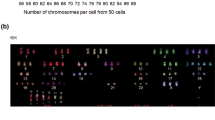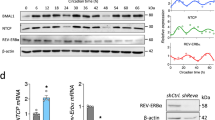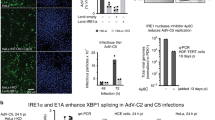Abstract
Chronic hepatitis C virus (HCV) infection is a leading cause of liver cirrhosis and hepatocellular carcinoma (HCC) worldwide. The HCV capside core is a multifunctional protein with regulatory functions that affects transcription and cell growth in vitro and in vivo. Here, we show that both HCV genotype 1a and 3 core proteins activate MEK1 and Erk1/2 MAP kinases and that the costitutive expression of the HCV core results in a high basal activity of Raf1 and MAP/kinase/kinase, as determined by endogenous Raf1 in vitro kinase assay and immunodetection of hyperphosphorylated Erk1 and Erk2 even after a serum starvation. Moreover, the activation of both Erk1/2 and the downstream transcription factor Elk-1 in response to the mitogenic stimulus EGF is significantly prolonged. The sustained response to EGF in cells expressing the HCV core occurs despite a normal induction of the MAP phosphatases MKP regulatory feedback and is likely due to the costitutive activation of Raf-1 activity. The ability of HCV core proteins to directly activate the MAP kinase cascade and to prolong its activity in response to mitogenic stimuli may contribute to the neoplastic transformation of HCV infected liver cells.
This is a preview of subscription content, access via your institution
Access options
Subscribe to this journal
Receive 50 print issues and online access
$259.00 per year
only $5.18 per issue
Buy this article
- Purchase on Springer Link
- Instant access to full article PDF
Prices may be subject to local taxes which are calculated during checkout


Similar content being viewed by others
References
Aoki H, Hayashi J, Moriyama M, Arakawa Y, Hino O . 2000 J. Virol. 74: 1736–1741
Barba G, Harper F, Harada T, Kohara M, Goulinet S, Matsuura Y, Eder G, Schaff ZS, Chapman MJ, Myamura T, Brechot C . 1997 Proc. Natl. Acad. Sci. USA 94: 1200–1205
Brondello JM, Pouyssegur J, McKenzie FR . 1999 Science 286: 2514–2517
Bruno S, Silini E, Crosignani A, Borzio F, Leandro G, Bono F, Asti M, Rossi M, Larghi A, Cerino A, Podda M, Mondelli MU . 1997 Hepatology 25: 754–758
Cacciola I, Pollicino T, Squadrito G, Cerenzia G, Orlando ME, Raimondo G . 1999 N. Engl. J. Med. 341: 22–26
Colombo M . 1999 J. Hepatol. 31: 25–30
De Francesco R . 1999 J. Hepatol. 31: 47–53
Donato F, Boffetta P, Puoti M . 1998 Int. J. Cancer 30: 347–354
Doria M, Klein N, Lucito R, Schneider RJ . 1995 EMBO J. 14: 4747–4757
Garrington TP, Johnson GL . 1999 Curr. Opin. Cell. Biol. 11: 211–218
Hayashi J, Aoki H, Arakawa Y, Hino O . 1999 Intervirology 42: 205–210
Hayashi J, Aoki H, Kajino K, Moriyama M, Arakawa Y, Hino O . 2000 Hepatology 32: 958–961
Ito Y, Sasaki Y, Horimoto M, Wada S, Tanaka Y, Kasahara A, Ueki T, Hirano T, Yamamoto H, Fujimoto J, Okamoto E, Hayashi N, Hori M . 1998 Hepatology 27: 951–958
Jin DY, Wang HL, Zhou Y, Chun AC, Kibler KV, Hou YD, Kung H, Jeang K-T . 2000 EMBO J. 19: 729–740
Kalkuhl A, Troppmair J, Buchmann A, Stinchcombe S, Buenemann CL, Rapp UR, Kaestner K, Schwarz M . 1998 Hepatology 27: 1081–1088
Klein NP, Schneider R . 1997 Mol. Cell. Biol. 17: 6427–6436
Lu W, Lo S, Chen M, Wu K, Fung YK, Ou J . 1999 Virology 264: 134–141
Mamiya N, Worman HJ . 1999 J. Biol. Chem. 274: 15751–15756
McKillop IH, Schmidt CM, Cahill PA, Sittzmann JV . 1997 Hepatology 26: 1484–1491
Moriya K, Yotsuyanagi H, Shintani Y, Fujie H, Ishibashi K, Matsuura Y, Miyamura T, Koike K . 1997 J. Gen. Virol. 78: 1527–1531
Moriya K, Fujie H, Shintani Y, Yotsuyanagi H, Tsutsumi T, Ishibashi K, Matsuura Y, Kimura S, Miyamura T, Koike K . 1998 Nat. Med. 9: 1065–1067
Morrison DK, Cuttler Jr RE . 1997 Curr. Opin. Cell Biol. 9: 174–179
Natoli G, Avantaggiati ML, Chirillo PL, Ianni A, Balsano C, Levrero M . 1994 Oncogene 9: 2837–2848
Ray RB, Meyer K, Ray R . 2000 Virology 271: 197–204
Schaeffer H, Weber M . 1999 Mol. Cell. Biol. 19: 2435–2444
Schmidt CM, McKillop IH, Cahill PA, Sitzmann JV . 1997 Biochem. Biophys. Res. Commun. 236: 54–58
Shibata Y, Nakata K, Tsuruta S, Hamasaki K, Hayashida Y, Kato Y, Nakao K, Eguchi K . 1999 Int. J. Oncol. 14: 1153–1156
Shrivastava A, Manna SK, Ray R, Aggarwal BB . 1998 J. Virol. 72: 9722–9728
Tamori A, Nishiguchi S, Kubo S, Koh N, Moriyama Y, Fujimoto S, Takeda T, Shiomi S, Hirohashi K, Kinoshita H, Otani S, Kuroki T . 1999 Hepatology 29: 1429–1434
Tsuchihara K, Hijikata M, Fukuda K, Kurori T, Yamamoto N, Shimotohno K . 1999 Virology 258: 100–107
You L, Chen C, Yeh T, Tsai T, Mai R, Lin C, Lee Y . 1999 J. Virol. 73: 2841–2853
Acknowledgements
This work was supported by a MURST-Cofin grant to C Balsano, and by grants from AIRC, ISS-Viral Hepatitis Project and Schering-Plough to M Levrero. Francesca Covone was supported by a fellowship from the Fondazione A Cesalpino.
Author information
Authors and Affiliations
Rights and permissions
About this article
Cite this article
Giambartolomei, S., Covone, F., Levrero, M. et al. Sustained activation of the Raf/MEK/Erk pathway in response to EGF in stable cell lines expressing the Hepatitis C Virus (HCV) core protein. Oncogene 20, 2606–2610 (2001). https://doi.org/10.1038/sj.onc.1204372
Received:
Revised:
Accepted:
Issue Date:
DOI: https://doi.org/10.1038/sj.onc.1204372
Keywords
This article is cited by
-
Systemic Therapy for Advanced Hepatocellular Carcinoma in an Evolving Landscape
Current Treatment Options in Oncology (2019)
-
LGR5 expression is regulated by EGF in early colorectal adenomas and governs EGFR inhibitor sensitivity
British Journal of Cancer (2018)
-
Advanced Hepatocellular Cancer: the Current State of Future Research
Current Treatment Options in Oncology (2016)
-
Erlotinib derivative inhibits hepatocellular carcinoma by targeting CIP2A to reactivate protein phosphatase 2A
Cell Death & Disease (2014)
-
Mutant p53-R273H gains new function in sustained activation of EGFR signaling via suppressing miR-27a expression
Cell Death & Disease (2013)



